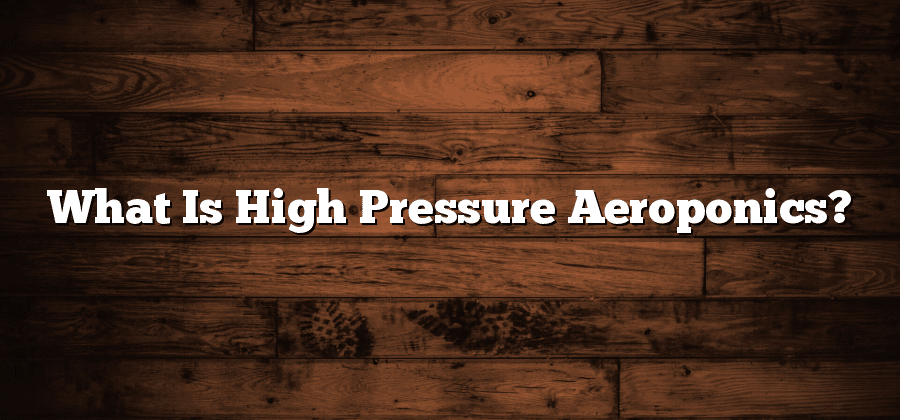The Concept of High Pressure Aeroponics
High Pressure Aeroponics is an innovative method of growing plants that utilizes a fine mist to deliver nutrients directly to the plant roots. Unlike traditional hydroponic systems which rely on a medium such as soil or water to support the plant roots, high pressure aeroponics suspends the roots in air and provides them with a highly oxygenated mist. This allows for optimal nutrient absorption and encourages rapid growth and development.
The key principle behind high pressure aeroponics is the use of a high-pressure pump to create a fine mist of nutrient solution. This mist is then delivered to the plant roots through specialized nozzles, providing a highly efficient and targeted irrigation system. By delivering nutrients directly to the roots in the form of a mist, high pressure aeroponics maximizes nutrient absorption and minimizes waste. The high pressure pump ensures that the mist is distributed evenly, covering all the roots for optimal nutrient delivery. This precise and efficient method of nutrient delivery allows plants to grow faster and yield higher crop production than traditional growing methods.
The Benefits of High Pressure Aeroponics
High Pressure Aeroponics offers numerous benefits that make it an attractive option for growers looking to maximize their crop yield. Firstly, this innovative system provides plants with highly oxygenated nutrient solution, resulting in faster growth rates and increased productivity. By delivering nutrients directly to the plant’s roots in a mist form, high pressure aeroponics ensures that each plant receives the necessary nutrients and moisture without the risk of over or under-watering.
Another advantage of high pressure aeroponics is its ability to promote stronger and healthier root development. With the nutrient solution being sprayed directly onto the roots in a highly oxygenated environment, plants are encouraged to develop larger and more fibrous root systems. This, in turn, allows for improved nutrient uptake and water retention, enhancing the overall health and vitality of the plants. Additionally, the absence of soil in this system helps to minimize the risk of plant diseases and pests, leading to healthier and more resilient crops.
Understanding the Science Behind High Pressure Aeroponics
In order to truly grasp the science behind high pressure aeroponics, it is essential to understand the principles on which this innovative agricultural technique is based. At its core, aeroponics involves suspending plant roots in air and periodically misting them with nutrient-rich water. This method eliminates the need for soil, providing plants with a highly oxygenated environment that aids in their growth and development. High pressure aeroponics takes this concept one step further by utilizing specialized pumps to produce a fine mist of water at significantly higher pressures, resulting in smaller water droplets and increased nutrient absorption.
The key scientific principle at play in high pressure aeroponics is the ability of plants to absorb nutrients through their roots via foliar uptake. When the water droplets produced by high pressure pumps are extremely small, they provide a larger surface area for nutrient absorption, allowing the plants to absorb the necessary elements more efficiently. Additionally, the high pressure mist ensures that the nutrient solution reaches every part of the root system, maximizing nutrient uptake and promoting rapid growth. By understanding these scientific principles, farmers and researchers can harness the potential of high pressure aeroponics to optimize crop production and address the challenges of traditional agricultural practices.
Components Required for High Pressure Aeroponics Systems
To set up a highly efficient high pressure aeroponics system, there are several essential components that you will need. First and foremost, you will require a high pressure pump, which is responsible for generating the intense pressure needed to mist the nutrient solution onto the plant roots. It is important to invest in a reliable and powerful pump that can consistently deliver the required pressure for optimal plant growth.
In addition to the pump, you will also need a high pressure filtration system. This ensures that the water used in the aeroponics system is free from any contaminants or impurities that could potentially harm the plants. The filtration system should be capable of effectively removing particles, sediment, and bacteria to maintain a clean and sterile environment for the plants.
The Role of High Pressure Pumps in Aeroponics
High pressure pumps play a crucial role in the field of aeroponics, ensuring the success of this innovative farming technique. These pumps are responsible for creating the ideal misting environment required for the growth of plants. By pressurizing water, the pumps force it through specialized nozzles, creating a fine mist that is dispersed over the plant roots. This mist contains both water and nutrients, supplying the plants with the optimal conditions they need to thrive.
The high pressure pumps used in aeroponics systems must be carefully selected to meet the specific demands of the system. They need to be robust and efficient, capable of generating the necessary pressure to atomize the water into tiny droplets. Additionally, high pressure pumps should be able to deliver a consistent flow rate for sustained periods of time, ensuring the plants receive a continuous supply of nutrients. As the heart of the aeroponics system, these pumps must also be reliable, able to handle the demands of daily operation without fail.






